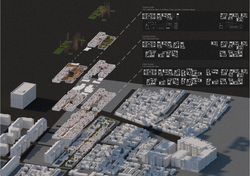+447470994564
Part 1 Year 3 BA Architecture Student
THIRD YEAR PROJECT:
HOUSING IN BEIJING
The project is based in the Ping An Li area of Beijing, within the 2nd ring road and northwest of the Forbidden City, at the heart of the city. The site is between a residential enclave of 5-6 storeys utilitarian housing blocks built in the 1980s, and a large area of traditional courtyard neighbourhoods (Hutongs) surrounding a historic buddhist temple. The local population is a mixture of old Beijingers who grew up in the courtyards and have overtime moved into the slab blocks, where they now face issues of accessibility and loneliness. There are the high-income new middle-class families drawn to the central location due to closeness to work and the outstanding local schools. There are rural migrants, doing most of the dirty jobs in Beijing, looking for cheap and informal accommodation.
 |  |  |
|---|---|---|
 |  |  |
 |  |  |
 |  |  |
 |  |
THIRD YEAR PROJECT:
POETICS OF HABITATION IN THE AGE OF GLOBAL MOBILITY
In semester 1, we used Somers Town in London as the site to develop prototype dwellings for transient families and individuals. A living laboratory of historic housing types in London, this was dedicated much of our time to observe, understand, and re-interpret the urban morphology of Somers Town, as well as the people who inhabit them. This also explores through our prototypes the meaning of transience and the architecture of transience. We particularly seek to break down the false equivalency between the transient and the temporary. Out of this substantial piece of research, will be a small scale proposal of prototypical homes on a small confined ‘testing’ site situated within the Godwin Court and Crowndale Court Estate.
 |  |  |
|---|---|---|
 |  |  |
 |  |  |
 |
SECOND YEAR PROJECT:
HEMP-DINGTON
The site is located next to Paddington Integrated Project, in Paddington, London, UK.
Its proposal is to be a public space for local people and tourists waiting for trains as they are usually late, and the station always being crowded and polluted, and absorbing CO2 from the motorway and Paddington Station, as they are the responsible for polluting the area
Its design includes a hemp roof garden, a hemp paper manufacturer, a hemp paper store, a new entrance to the tube station and a public space where people can stay and wait for their train in a non-polluted space.
The building uses plant-based materials such as: biopolymers, timber, glulam, and rope, all made locally, recycled or plant-based.
Growing hemp as it grows fast and it absorbs a lot of CO2
Trains produce 4050 tonnes of CO2/year, the hemp plantation would absorb 900 kg C02/year.
 |  |  |
|---|---|---|
 |  |  |
 |  |  |
 |  |
SECOND YEAR PROJECT:
BOATER'S HOUSE
Starting with the concept of the 15 minute-city across the Little Venice Canal, the aim is to bring closer needs that locals need, more specifically boat livers. They represent a unique community, experiencing a pretty different lifestyle, and having boats as homes. There are boaters that live in Little Venice permanently paying a mooring of £1000/month, and there are others that don't want to settle in a place to skip rent payments, so they have to move every 14 days for at least 3 miles away. Little Venice is a mooring environment that provides the main needs of boaters such as water, toilets, refuse disposal, and pump-out so people living here don't lack the most essential aspects. There is a research which suggests that being near the water presents an opportunity for
well-being and makes people happier, the fact that explains why boaters have such a strong connection, bringing them together, creating groups, communities, organisations and partnerships, one you've got a boat you already joined the 'club'. Most say that if you live on a boat every boater will be friendly, will be helpful, and will even invite you over for a cup of coffee.
Moreover, this community has a big volunteering potential, people always
being devoted to their "home" and trying to make it a better place to live in. Due to the fact that they live in small places, they are more careful with the use of resources. People that are living on a boat seem more environmentally aware and mindful of reducing their waste. The community also has a mini garden near the canal, where the boaters come to the garden and socialize.
 |  |  |
|---|---|---|
 |  |  |
 |  |  |
 |
FIRST YEAR PROJECT:
HOUSE OF A COLLECTOR
The client of this proposal, Luigi Lineri, is a stone collector. His collectioner story began around 50 years ago, while walking by a lake, he saw a stone on the shore and he picked it. He looked at it and immediately saw a form, but not an eroded stone one, but one which seemed to have been sculpted by a prehistoric human being. From that day, he dedicated all his life to stone exploration and its ‘alphabet’.
This house embodies elements of Italian architecture, and sustainable materials, such as mycelium bricks, and stones. The building is divided into 2 separated parts, one is Luigi Lineri's home in London, and the other is his collection which is open to the public.
 |  |  |
|---|---|---|
 |  |  |
 |  |  |
 |

